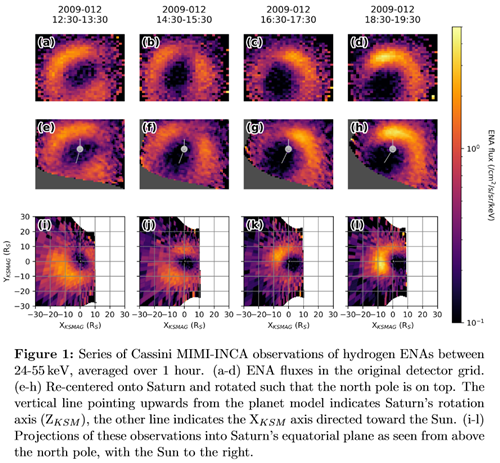Towards a complete dataset of equatorial projections of Saturn's ENA emissions observed by Cassini/INCA
- 1Lancaster University, Physics, Lancaster, United Kingdom of Great Britain and Northern Ireland (lxbader@gmail.com)
- 2Johns Hopkins University Applied Physics Laboratory, Laurel, MD, USA
Observations of energetic neutral atoms (ENAs) are a useful tool for analyzing ion and neutral abundances in planetary magnetospheres. Saturn's magnetosphere is dominated by high densities of water group neutrals which originate from the icy moon Enceladus and are confined close to the equatorial plane due to the planet's rapid rotation rate. Hot plasma populations are mainly created by magnetotail reconnection events and driven inward with the subsequent magnetic field dipolarization to form a so-called "injection". As this hot plasma interacts with the ambient neutral population, charge exchange creates ENAs whose motion is not governed by the magnetic field anymore, such that they can be observed remotely allowing us to image Saturn's ring current on a global scale.
Over the course of the Cassini mission, the Ion Neutral Camera (INCA) of the Magnetosphere Imaging Instrument (MIMI) collected vast amounts of hydrogen and oxygen ENA observations of Saturn's magnetosphere from a variety of different viewing geometries. In order to enable statistical investigations of the morphology and dynamics of Saturn's ring current, it is useful to re-bin and re-project the camera-like views from the spacecraft-based perspective into a common reference frame.
We developed an algorithm which projects ENA observations by the MIMI-INCA instrument into a regular grid in Saturn's equatorial plane, spanning from -30 to +30 Saturn radii in the XKSMAG and YKSMAG axes of the Kronocentric Solar Magnetic (KSMAG) reference frame with a resolution of 2 pixels per Saturn radii. With most neutrals and ions being confined into an equatorial rotating disc, this projection is quite accurate in both spatial location and measured ENA intensity, provided the spacecraft is located at large enough perpendicular distances from the equatorial plane such that the viewing angle is not too flat.
The INCA dataset can exhibit several different kinds of contamination: sunlight entering the detector may lead to artificial intensifications, and bit errors during data transmission may result in wrong count numbers. High ENA fluxes may exceed the limit up to which the instrument calibration is valid, and energetic ion beams bypassing the high voltage deflector and entering the detector may lead to artifacts not representing the actual ENA intensity. Many of these events have been identified by the instrument team and tables are available with INCA calibration files, but ion contamination events were so far not identified - we developed an algorithm identifying these to complement previous exclusion lists.
Our dataset of projections includes all days during which Cassini was located at >4 RS off the equatorial plane, and will be provided as a zip archive of daily files in .fits format. A Python routine for loading these files into a useful array format will be provided, returning not only ENA intensity data but also various geometric information detailing the spacecraft's location as well as data quality flags. This allows the user to easily set validity constraints depending on the spacecraft distance from and elevation above each pixel and highlights which exposures may be contaminated.
The resulting dataset is a good foundation for investigating the statistical properties of Saturn's ring current as well as its complicated dynamics in relation to other remote and in situ observations of, for example, auroral emissions and magnetotail reconnection events.

How to cite: Bader, A., Kinrade, J., Badman, S. V., Paranicas, C., Constable, D. A., and Mitchell, D. G.: Towards a complete dataset of equatorial projections of Saturn's ENA emissions observed by Cassini/INCA, Europlanet Science Congress 2020, online, 21 September–9 Oct 2020, EPSC2020-300, https://doi.org/10.5194/epsc2020-300, 2020

